20 Picture Books for 2020: Readings to Embrace Race, Provide Solace & Do Good
by Autumn Allen, Krista Aronson and the Diverse BookFinder Team, and Megan Dowd Lambert
Parents and other caregivers are seeking resources to help them hold children through the current, terrible wave of racialized violence, which is exacerbated by the tensions and vulnerabilities exposed by the COVID-19 pandemic. As scholars, writers, and parents who use books to connect with our children and spark conversations with them, we’ve developed this book list to help engage the broad range of emotions and needs of diverse children in our multiracial society. In some cases, we’ve highlighted worthy, albeit lesser-known titles. Some are older books, some are newer, and a few will publish later this year but are available for pre-order now. This list skews heavily towards #ownvoices books and is arranged alphabetically by title.
Please use these books to help you do the work of making the world a safer, more equitable place for all children.
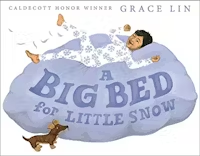
A Big Bed for Little Snow
by Grace Lin, Little Brown, 2019
This companion title to Lin’s Caldecott Honor book, A Big Mooncake for Little Star offers a whimsical, original porquoi tale to explain the source of snowstorms. It shouldn’t be notable that the protagonist is an Asian boy, but unfortunately, it is, with the CCBC reporting only 7% of children’s books published in 2018 featuring API/APA characters (a statistic that says nothing about the quality of the representation in those titles). Lin has said that these two picture books signal a shift from a focus in her work on her Asian heritage to one of claiming her American identity. Such a shift feels particularly important now, as political leaders and conspiracy theories blame the pandemic on China and fan anti-Asian sentiment in the United States by depicting Asian people as inherently un-American. We believe that small acts like sharing picture books with Asian characters as protagonists can add up to help resist the racist exotification at the heart of much of the racism Asian Americans face.
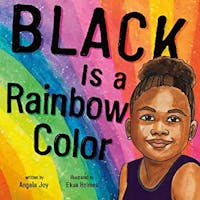
Black is a Rainbow Color
by Angela Joy, illustrated by Ekua Holmes, Roaring Brook Press, 2020
Joy’s rhythmic verses and Holmes’s vivid artwork combine to offer a celebration of Black American culture and history that connects current movements for social justice to past Civil Rights movements, offering context and continuity between generations. On one spread, “Black is the power of a movement in pain” accompanies pictures of people holding signs saying “I am a man,” “Equal Rights,” and “Black Lives Matter.” The powerful images alternate between everyday children and families, and famous historical figures such as Thurgood Marshall, Billie Holiday, and Paul Lawrence Dunbar, whose work is referenced poetically in the text. Two verses repeat throughout the pages: “Black is a color. / Black is a culture” and “My color is Black.” While the references to history, art, and culture will be familiar to many adult readers, an afterword provides details for sharing with children. The backmatter also includes other valuable information: poems, a playlist of songs, a timeline of names for African Americans, and a bibliography with further reading for adults. In a starred Horn Book review, Autumn calls it “a treasure trove of positivity, strength, and pride for anyone seeking to uplift and educate young people.”
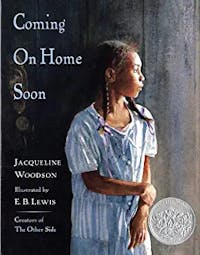
Coming on Home Soon
by Jacqueline Woodson, illustrated by E.B. Lewis, Penguin Random House, 2004
This Caldecott Honor title has a historical context that will resonate with many contemporary children whose loved ones are essential workers. Set during WWII, Woodson’s story is about a young African American girl named Ada Ruth whose mother leaves their rural home to work in Chicago in support of the war effort. (On her website Woodson says, “I had been reading stories about Rosie the Riveter and couldn’t find any with African American women in them so I started researching.”) Ada Ruth and her grandmother stick to their daily routines in warm scenes of domesticity that evoke both the strength of their bond and the longing they share for their loved one’s return. Many children today are worried about loved ones who are essential workers in hospitals, nursing homes, grocery stores, and elsewhere, putting their own wellbeing on the line to help our society. This book affirms how hard it is to miss someone and to worry about them, and how memories and hope can help ease such longing. For a book with similar themes and tone, but different cultural context, see Town is by the Sea by Joanne Schwartz, illustrated by Sydney Smith, which is about a Nova Scotian boy waiting for his father to return from working in the coal mines under the sea.
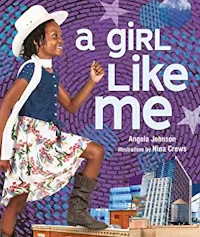
A Girl Like Me
by Angela Johnson, illustrated by Nina Crews, Lerner Books 2020
A Girl Like Me uses photographs to present diverse children in the fullness of their humanity. In a moment when the phrase “Black Lives Matter” is still deemed controversial by some, we desperately need more books like these read at storytimes, bedtime, anytime and anywhere. Megan’s starred review of A Girl Like Me in the Horn Book Magazine calls it “a rallying cry for girls to reject limitations others might place on them and their dreams,” and Crews’s photo collages specifically center Black girls and other girls of color.
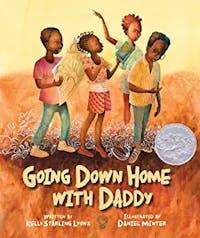
Going Down Home with Daddy
by Kelly Starling Lyons, illustrated by Daniel Minter, Peachtree Publishing Company, 2019
“Nothing is more important than family,” says great-grandmother Granny in this moving and beautiful book, which has us looking forward to the day we can reunite, unmasked, to share traditions with those to whom we belong. Kelly Starling Lyons portrays in poetic text the deep richness and joy of multigenerational Black family life, defined by love, not by loss. Illustrator and fine artist Daniel Minter won a long-overdue Caldecott Honor for his stunning art which, according to his website, “comes from a soul at home at the crossroads, at home where ancient ritual and future possibilities hold the hand of the present, at home where prayers and soul songs are made concrete, where the rooted artifice of history can transform everyday tools into sacred objects and everyday people into sacred subjects.” This vivid evocation of a very particular cultural experience has the power to touch readers of all backgrounds with the universal truth of what it means to return to the people and the places in which we are rooted. All these layers are woven into the sweet story of a young boy’s journey to take his place and tell his story among his kin.
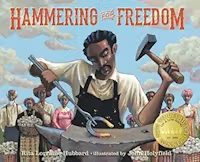
Hammering for Freedom
by Rita Lorraine Hubbard, illustrated by John Holyfield, Lee & Low, 2018
Books about contemporary Black children are extremely important today. Occasionally, though, a book is published that shines light on a little-known historical story that is all the more impactful because it is true. So it is with Hammering for Freedom, a Lee & Low Books New Voices Award winner about an enslaved man named William Lewis, who became a skilled blacksmith at a young age and was able to save enough coins to buy his freedom. His story doesn’t end there: what Bill wanted most was to free his family. He opened his own shop and worked tirelessly, saving for years until, one by one, he purchased the freedom of each member of his family. With so much tragedy and difficult news today, it is easy to lose hope and to wonder if our small efforts are insignificant. But just as Bill’s hard work and savings were everything to each person he freed, our actions add up to hope for a better future for ourselves and others. Bill’s hope, faith, and eventual success can remind us that even in times of turmoil and doubt, consistency and perseverance can take us far, and that justice begins with caring for our families.
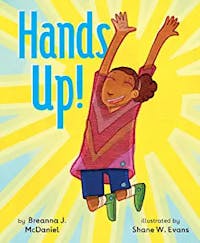
Hands Up!
by Breanna J. McDaniel, illustrated by Shane W. Evans, Dial Books for Young Readers, 2019
As we’ve seen the protests in our country create change and spur calls for broader reforms in policing, and in the ways our economy works (or doesn’t work) for many people, we keep returning to a quotation from the late, great, African American poet and children’s book author, Lucille Clifton: “We cannot create what we can’t imagine.” This is a time for radical imagination about how we might reshape society—not to return to “normalcy” but to create a new normal that is more equitable, just, and safer for everyone. This picture book embodies just that sort of radical imagination with its reframing of the phrase “Hands Up!” in the context of one young, Black life. Never do McDaniel and Evans present protagonist, Viv, experiencing those words in the context of a police encounter. Instead, this book operates as what Critical Race Theory calls a “counternarrative” or “counter-story” to present this little Black girl raising her hands to answer a question in class, to reach a book on a shelf, to block a basketball shot, to embrace a loved one who picks her up when she falls. Anti-racist children’s booklists must include books that center a full range of BIPoC experiences—not just protest, pain, and struggle. This picture book does just that with its spare text and vivid art. (Look, too, for Evans’s brilliant, empowering picture books We March and Underground: Finding the Light to Freedom.)

A Map into the World
by Kao Kalia Yang, illustrated by Seo Kim, Lerner Books, 2019
This lovely, quiet story of a young girl, her family, their new house, and the couple across the street is only the second picture book by a Hmong American writer published in the U.S. When their elderly neighbor dies, Paj Ntaub finds an artistic way to express her sympathy and sense of connection to his widower. Themes of birth and death, loss and grief, are paired with the hope that a child’s simple action can make a difference, and the close attention to seasonal changes in the natural world in and near the family’s yard has added meaning at a time when many children are not leaving home. Young readers may also connect the story to the #ChalkTheWalk response to the pandemic, and want to create their own positive messages. Good news, too: Yang, author of the adult memoir, The Latehomecomer: A Hmong Family Memoir, has two more picture books featuring Hmong families coming out in 2020: Look for her just-released The Shared Room, and the drawn-from-life story, The Most Beautiful Thing, coming in the fall.
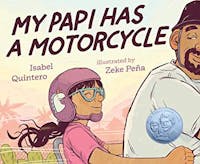
My Papi has a Motorcycle
by Isable Quintero, illustrated by Zeke Peña, Penguin Random House, 2019
This joyful, vibrant picture book presents a loving father-daughter story through the effective use of comics visual vocabulary. As Daisy and her father tour their favorite spots, she expands on the charms of their beloved, working-class town — Corona, California. “Daisy's experiences mirror Quintero's childhood memories, recounted through tender language and vivid sensory details,” writes reviewer Jessica Agudelo in School Library Journal. “Recalling the motorcycle rides with her papi is an exercise in familial love, but also a way to honor a hometown and present the changes from gentrification. Although the topic is touched upon lightly, its complexity percolates and becomes much more vivid with multiple reads.” The book’s core message, “Home is a feeling you take with you,” can offer comfort to readers across all kinds of communities who are experiencing instability and uncertainty in this moment.
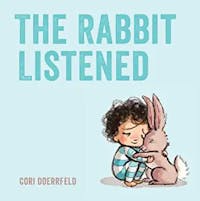
The Rabbit Listened
by Cori Doerrfeld, Dial Books for Young Readers, 2018
There’s so much pain in our country right now. We know this isn’t new. And, as parents, we also know that when our kids present us with their pain our (frequently counterproductive) impulse is to try to fix it, fix it, fix it. In that context, and in others, radical empathy manifested in just plain listening to someone else’s experience can be a path toward healing, or even reconciliation. This wise picture book exemplifies that truth as it tells the story of Taylor (whose race and gender are never specified in the text), when a flock of crows destroys their carefully constructed block tower. We’ve found it helpful to read this story metaphorically, and we think it can be an imminently useful and healing picture book in this moment and beyond.
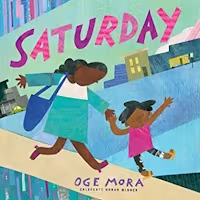
Saturday
by Oge Mora, Little Brown & Co., 2020
Megan started recommending this picture book about plans gone awry and love between a Black mother and daughter as soon as she read it. It’s a perfect picture book in her estimation, with words, pictures, and design working together to create a sum greater than its parts. (We were all delighted that the 2020 Boston Globe-Horn Book Award Committee agreed with her, naming this book as the Picture Book Medalist just recently.) When the pandemic prompted school closings and the disruption of so very many events and activities, this book became even more important to her for its healing, warm depiction of a mother and child confronting disappointment and cancelled plans. That they are a Black mother and daughter makes this book even more important in this moment, as this story centers Black love, joy, creativity, and resilience.
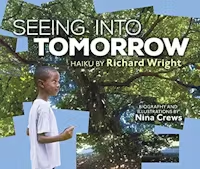
Seeing into Tomorrow: Haiku by Richard Wright
illustrated by Nina Crews, Lerner Books, 2018
With the picture book Seeing into Tomorrow: Haiku by Richard Wright, illustrator Nina Crews uses photographs to present diverse children being themselves. (She did the same as illustrator for A Girl Like Me listed above.) Autumn writes (in the Horn Book) of Crews’s work in Seeing into Tomorrow: “Crews may have done her best work by using photographic collage to highlight the observed piece of nature and the observer — Black boys representing the young Richard Wright and all of their infinite possibilities of creation. The more we see concrete images of Black boys as creators of their own destinies, attached to the infinite possibilities of the world, the more these ideas can settle into our minds as real and not imagined. What a gift to a society in need.”
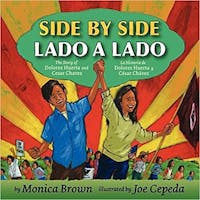
Side by Side / Lado a Lado: The Story of Dolores Huerta and Cesar Chavez/La Historia de Dolores Huerta y Cesar Chavez
by Monica Brown, illustrated by Joe Cepeda, HarperCollins, 2010
Throughout the pandemic and the protests, essential workers have been continuing to labor, risking their lives to support their own families — and others’ families, too. This bilingual book focuses on the collaborative leadership of two inspiring activists, Dolores Huerta and Cesar Chavez, and the history of the multiracial movement to improve working conditions for farmworkers. Beginning with stories from their childhoods, this dual biography can engage young readers in imagining how they might grow up to work for justice — and provide hope that people can create change. ¡Si Se Puede!
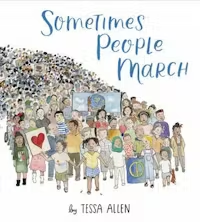
Sometimes People March
by Tessa Allen, HarperCollins, 2020
Designed to share with the youngest of readers, this simple picture book combines spare text with carefully drawn and delicately watercolored illustrations of people participating in historical and recent social movements. Explaining that, like ants and bands, people are stronger when they march together, this book focuses on the human emotions that motivate people to engage in public protests: concern for causes and people that they care about. With its general language and the specific examples drawn in through illustrations and extensive backmatter, this title offers a perfect way to begin a conversation with young children about what makes people take to the streets, and what marching has accomplished throughout history. An educator’s guide for use with this title, created by Autumn, will be available on the publisher’s website, and the author’s letter to the reader can help caregivers contextualize the conversations about hope, courage, togetherness and change that may lead into and spring from reading this book.
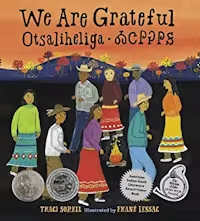
We Are Grateful: Otsaliheliga
by Traci Sorell, illustrated by Frané Lessac, Charlesbridge, 2018
We’ve heard of many people practicing mindful gratitude throughout the pandemic, trying to find silver linings to sustain them amidst the worries, hardships, and outright tragedies they are facing. We can think of know of no other picture book that better exemplifies that spirit of giving thanks than this one. We know that the COVID-19 crisis is having a disproportionate impact on Indigenous nations and communities, and so we think it’s important to center depictions of contemporary, Indigenous people like this one, which is rooted in the author’s lived experience as a citizen of the Cherokee nation.

We Are Water Protectors
by Carole Lindstrom, illustrated by Michaela Goade, 2020
One of the most visible, memorable resistance movements of recent times is that led by Native people to protect water sources from corporate pollution. In this beautifully illustrated picture book, a young Ojibwe girl tells the story of a community coming together to protect this sacred resource. Weaving in traditional storytelling and imagery, this book offers courage and inspiration for people seeking to make change. “It will not be easy,” Lindstrom writes, but “We fight for those/ Who cannot fight for themselves,” from small and large creatures, to the land and trees, because “We are all related.” The book ends with a pledge for readers to sign to commit to being an Earth steward and water protector. If the very source of life cannot connect us all, then what else can?
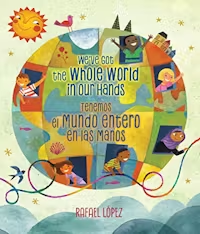
We’ve Got the Whole World in Our Hands/Tenemos El Mundo Entero en las Manos
by Rafael López, Orchard Books, 2018
We’ve been thinking a lot about how stay-at-home orders are about the common good, and we’re trying to communicate that message to our kids and to others in our circles of family and friends. Although Rafael López’s picture book has a clear green/environmentalist focus, we think it also speaks to the sense of mutuality at the heart of any hopes we have in the midst of this pandemic and the simultaneous wave of racialized violence occurring in the United States. Its words and pictures embody the values of interconnectedness we want to live and to pass on to our children.

When Aidan Became a Brother
by Kyle Lukoff, illustrated by Kaylani Juanita, Lee & Low Books, 2019
Like Going Down Home with Daddy, mentioned below, this picture book makes us long for times when entire families can enjoy milestones and celebrations together. Setting “a new standard of excellence in transgender representation by centering the feelings of Aidan, a biracial (black and South Asian) transgender boy,” (Kirkus Reviews), this Stonewall Book Award winner also uplifts current efforts to mobilize in defense of all Black lives. The narrative thread that mistakes can be fixed, harm addressed, and understanding can grow is a poignant theme for the times we live in. Meanwhile, the humorous, tender text, and playful, fanciful illustrations portray a deeply loving, multiracial, extended family and offer a heartfelt call to accept every person for “exactly who they are.”
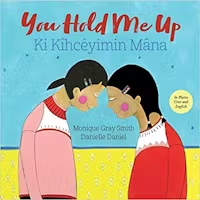
You Hold Me Up/Ki Kîhcêyimin Mâna
by Monique Gray-Smith, illustrated by Danielle Daniel, Orca Books, 2017
We know the COVID-19 crisis has had a disproportionate impact on Indigenous nations and communities in the United States. We also know that the mental health impact of social distancing and the uncertainty brought on by the pandemic is profound for everyone. These are just two reasons why this spare, vibrant picture book holds such meaning for us as it centers loving depictions of contemporary Indigenous people (some editions include text in Plains Cree and English) while communicating the universal human need for finding strength in supportive, affirming relationships.

Your Name Is a Song
by Jamilah Thomkins-Bigelow, illustrated by Luisa Uribe, Innovation Press, 2020
Thomkins-Bigelow’s picture-book debut, Mommy’s Khimar illustrated by Ebony Glenn (2018), offers a joyful representation of a little girl within a supportive Muslim American family and community, and this forthcoming picture book beautifully portrays a young girl learning that she can teach others the beauty of diverse names. The protagonist ends her first day at school sad because her teacher could not pronounce her name, but her sadness is short-lived. As they walk through their neighborhood, dancing to the sounds around them, her mother shows her how every name has its own kind of music, using examples from many cultures, and responding to the claim that the girl’s name is “made-up” by saying that “Made-up names come from dreamers” who “make a way out of no way.” Among the “made-up” names invoked on this spread is Trayvon, a reference that honors one of many victims of anti-Black violence as it implicitly ties the light issue of naming differences to the more serious issue of valuing life. By the time the girl starts her second day of school, she confidently sings both her own unique name and her teacher’s and classmates’ Anglo names, Ms. Anderson and Bob. The messages in this lovely book can open conversations about the less obvious ways in which White supremacist ideology is passed on: the upholding of certain cultural practices as normal and others as substandard.

Autumn Allen

Krista Aronson

Megan Dowd Lambert
Get Insights In your Inbox
Join the EmbraceRace community! You will receive the newsletter with our latest on race & kids, including upcoming events and opportunities, resources, community news and curated links.
Subscribe


